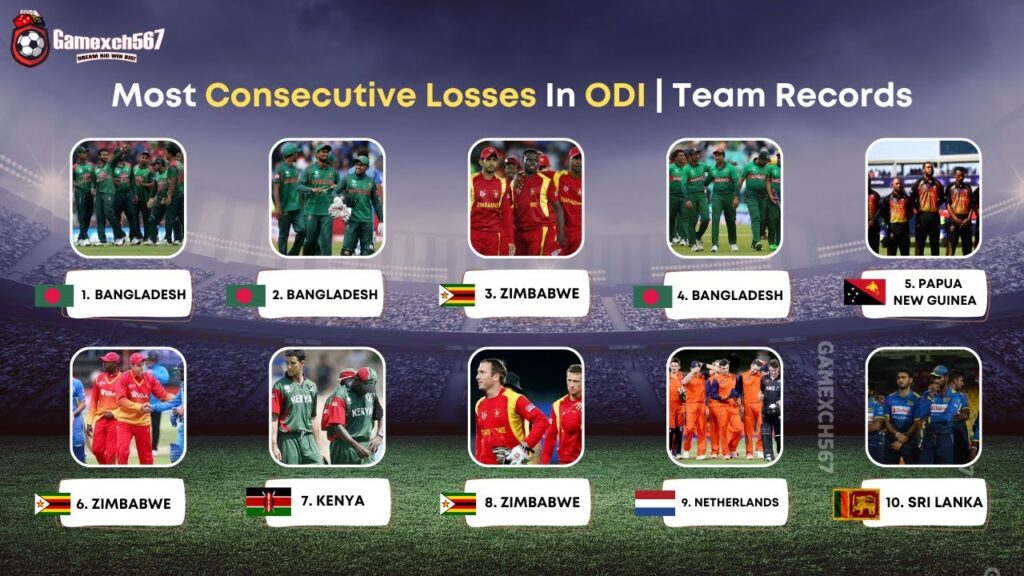
Cricket, often a game of glorious uncertainties, has witnessed its fair share of triumphs and hardships.
In One Day International (ODI) cricket, where teams battle it out over limited overs, there is a unique measure of resilience defined by consecutive victories and, conversely, a daunting challenge in the face of successive losses.
In this article, we will explore the top 10 cricket teams with the most consecutive losses in ODI.
List of Teams With the Most Consecutive Losses in ODI:
| Sr.No. | Country | Number of Consecutive Losses in ODI |
| 1 | Bangladesh | 23 |
| 2 | Bangladesh | 22 |
| 3 | Zimbabwe | 18 |
| 4 | Bangladesh | 18 |
| 5 | P.N.G. | 18 |
| 6 | Zimbabwe | 17 |
| 7 | Kenya | 16 |
| 8 | Zimbabwe | 16 |
| 9 | Netherlands | 15 |
| 10 | Sri Lanka | 14 |
- Bangladesh (23 Consecutive Losses)
From October 1999 to October 2002, Bangladesh faced a significant challenge with 23 consecutive losses in ODIs.
However, this challenging period became a turning point in their cricketing journey.
It prompted them to thoroughly reevaluate their strategies, player development, and overall approach to the game.
The management and players put in tremendous effort to identify weaknesses and areas that required improvement.
This process of introspection and learning paved the way for significant changes in their cricketing structure, leading to their eventual resurgence in international cricket.
- Bangladesh (22 Consecutive Losses)
Another period of consecutive losses occurred from March 1986 to May 1998, during which Bangladesh experienced 22 defeats.
It was a critical phase in their cricketing history, marked by deep contemplation and determination to improve.
The players and coaching staff worked diligently to address their shortcomings and enhance their cricketing skills.
- Zimbabwe (18 Consecutive Losses)
Zimbabwe faced a challenging stretch of 18 consecutive losses in ODIs from June 1983 to March 1982. This period caused them to rethink their cricketing strategies.
It led to significant changes in their approach to the game, including player development and infrastructure.
It ultimately resulted in improved performances and a renewed sense of competitiveness on the international stage.
- Bangladesh (18 Consecutive Losses)
Bangladesh’s 18 consecutive losses from February 2003 to November 2003 included challenges and learnings.
It was a pivotal time for them to reassess and come back stronger in international cricket.
- Papua New Guinea (P.N.G.) (18 Consecutive Losses)
P.N.G. found itself in a challenging situation from August 2019 to March 2022, experiencing a series of 18 consecutive losses.
This period of adversity tested their resilience and determination. It required them to reevaluate their approach to the game, focusing on player development and their cricketing infrastructure.
- Zimbabwe (17 Consecutive Losses)
Zimbabwe’s 17 consecutive losses from April 2004 to December 2004 marked a period of struggle and reflection.
During this time, they identified areas that required adjustment and improvement.
This phase urged them to make vital changes, not only in strategy but also in nurturing talent and cricketing infrastructure.
These adjustments ultimately led to better performances in the future.
- Kenya (16 Consecutive Losses)
Kenya faced a challenging phase from March 1999 to October 2001, enduring 16 consecutive losses.
It was during this time that Kenya made critical changes to become more competitive on the international stage.
- Zimbabwe (16 Consecutive Losses)
Another instance of 16 consecutive losses from June 2001 to October 2001 in Zimbabwe’s cricketing history highlighted their determination to overcome hardship.
This challenging phase prompted them to reevaluate their approach to the game, including player development and infrastructure.
The lessons learned during this period led to eventual improvements in their cricketing performance.
- Netherlands (15 Consecutive Losses)
In early 2022, the Netherlands experienced a series of 15 consecutive losses, a period that showcased their resilience and determination to bounce back.
This challenging phase was a significant one in their cricketing journey.
It motivated them to assess their cricketing strategies, player development, and overall approach to the game.
The commitment and hard work during this time would lay the foundation for future success.
- Sri Lanka (14 Consecutive Losses)
Sri Lanka experienced 14 consecutive losses from January 1987 to January 1988.
Sri Lanka made significant changes in terms of talent development, infrastructure, and cricketing tactics.
These adaptations enabled them to come back stronger in international cricket and eventually become a powerhouse in the sport.
Factors Contributing to Consecutive Losses
Consecutive losses in ODI cricket can be credited to different factors, and understanding these elements can shed light on the challenges teams face during such difficult periods.
Poor Form: Players can go through phases where their skills are not at their peak. It could result from a lack of practice or external pressures.
Injuries: Injuries to key players can significantly affect a team’s performance. Losing a star player or multiple players to injuries can weaken the team’s overall ability.
Team Selection: Making the right choices in team selection is crucial. Sometimes, teams might not pick the best-suited players for a particular condition or format, leading to losses.
Mental State: A team’s mental state plays a pivotal role. Lack of confidence and motivation can result in poor decision-making and performance on the field.
Adaptation: Teams that fail to adapt to changing conditions, strategies, or opposition tactics face consecutive losses.
Impact of Consecutive Losses
The consequences of a team enduring the most consecutive losses in ODI are far-reaching. These effects can be felt in various aspects of the team’s dynamics:
- Team Morale: Continuous defeats can severely dent team morale. Players may feel demotivated, leading to a lack of enthusiasm and a negative atmosphere within the squad.
- Fan Support: Sustained losses can erode fan support and enthusiasm for the team. Fans may become disillusioned and less likely to support the team during matches.
- Captain and Coach Pressure: Captains and coaches come under intense pressure when a team is facing a losing streak. They must navigate these challenges while making strategic decisions.
- Learning Opportunities: However, consecutive losses can also serve as learning opportunities. They push teams to reevaluate their strategies, improve performance, and identify areas that need strengthening.
It’s important to note that consecutive losses are not unique to cricket.
Similar experiences have occurred in various other sports, including football, basketball, and more.
In these cases, teams face analogous challenges and have had to find ways to bounce back from adversity.
In conclusion, the top 10 teams with the most consecutive losses in ODI cricket serve as a reminder that even the best teams can go through challenging phases.
Understanding the factors contributing to consecutive losses and their effects on team dynamics is crucial for teams to recover and regain their competitive edge.
Through introspection, strategic adjustments, and unwavering determination, teams can turn their fortunes around, proving that resilience and adaptability are essential qualities in the world of sports.
Also check out Top 10 Batsmen with the Most Fifties in ODI Cricket [2023]








